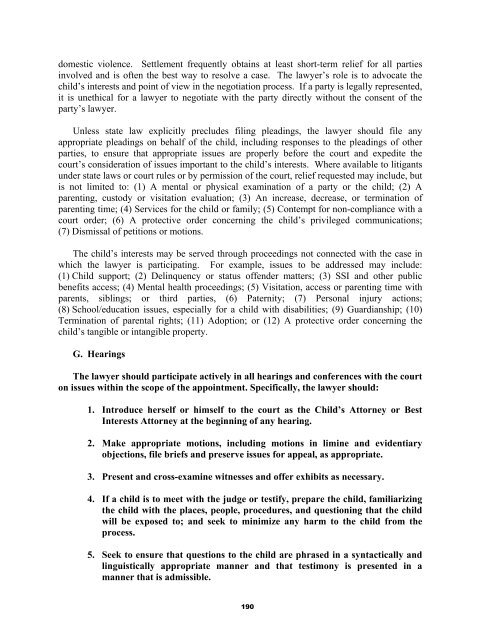A Judge’s Guide
A Judge’s Guide
A Judge’s Guide
You also want an ePaper? Increase the reach of your titles
YUMPU automatically turns print PDFs into web optimized ePapers that Google loves.
domestic violence. Settlement frequently obtains at least short-term relief for all parties<br />
involved and is often the best way to resolve a case. The lawyer’s role is to advocate the<br />
child’s interests and point of view in the negotiation process. If a party is legally represented,<br />
it is unethical for a lawyer to negotiate with the party directly without the consent of the<br />
party’s lawyer.<br />
Unless state law explicitly precludes filing pleadings, the lawyer should file any<br />
appropriate pleadings on behalf of the child, including responses to the pleadings of other<br />
parties, to ensure that appropriate issues are properly before the court and expedite the<br />
court’s consideration of issues important to the child’s interests. Where available to litigants<br />
under state laws or court rules or by permission of the court, relief requested may include, but<br />
is not limited to: (1) A mental or physical examination of a party or the child; (2) A<br />
parenting, custody or visitation evaluation; (3) An increase, decrease, or termination of<br />
parenting time; (4) Services for the child or family; (5) Contempt for non-compliance with a<br />
court order; (6) A protective order concerning the child’s privileged communications;<br />
(7) Dismissal of petitions or motions.<br />
The child’s interests may be served through proceedings not connected with the case in<br />
which the lawyer is participating. For example, issues to be addressed may include:<br />
(1) Child support; (2) Delinquency or status offender matters; (3) SSI and other public<br />
benefits access; (4) Mental health proceedings; (5) Visitation, access or parenting time with<br />
parents, siblings; or third parties, (6) Paternity; (7) Personal injury actions;<br />
(8) School/education issues, especially for a child with disabilities; (9) Guardianship; (10)<br />
Termination of parental rights; (11) Adoption; or (12) A protective order concerning the<br />
child’s tangible or intangible property.<br />
G. Hearings<br />
The lawyer should participate actively in all hearings and conferences with the court<br />
on issues within the scope of the appointment. Specifically, the lawyer should:<br />
1. Introduce herself or himself to the court as the Child’s Attorney or Best<br />
Interests Attorney at the beginning of any hearing.<br />
2. Make appropriate motions, including motions in limine and evidentiary<br />
objections, file briefs and preserve issues for appeal, as appropriate.<br />
3. Present and cross-examine witnesses and offer exhibits as necessary.<br />
4. If a child is to meet with the judge or testify, prepare the child, familiarizing<br />
the child with the places, people, procedures, and questioning that the child<br />
will be exposed to; and seek to minimize any harm to the child from the<br />
process.<br />
5. Seek to ensure that questions to the child are phrased in a syntactically and<br />
linguistically appropriate manner and that testimony is presented in a<br />
manner that is admissible.<br />
190


